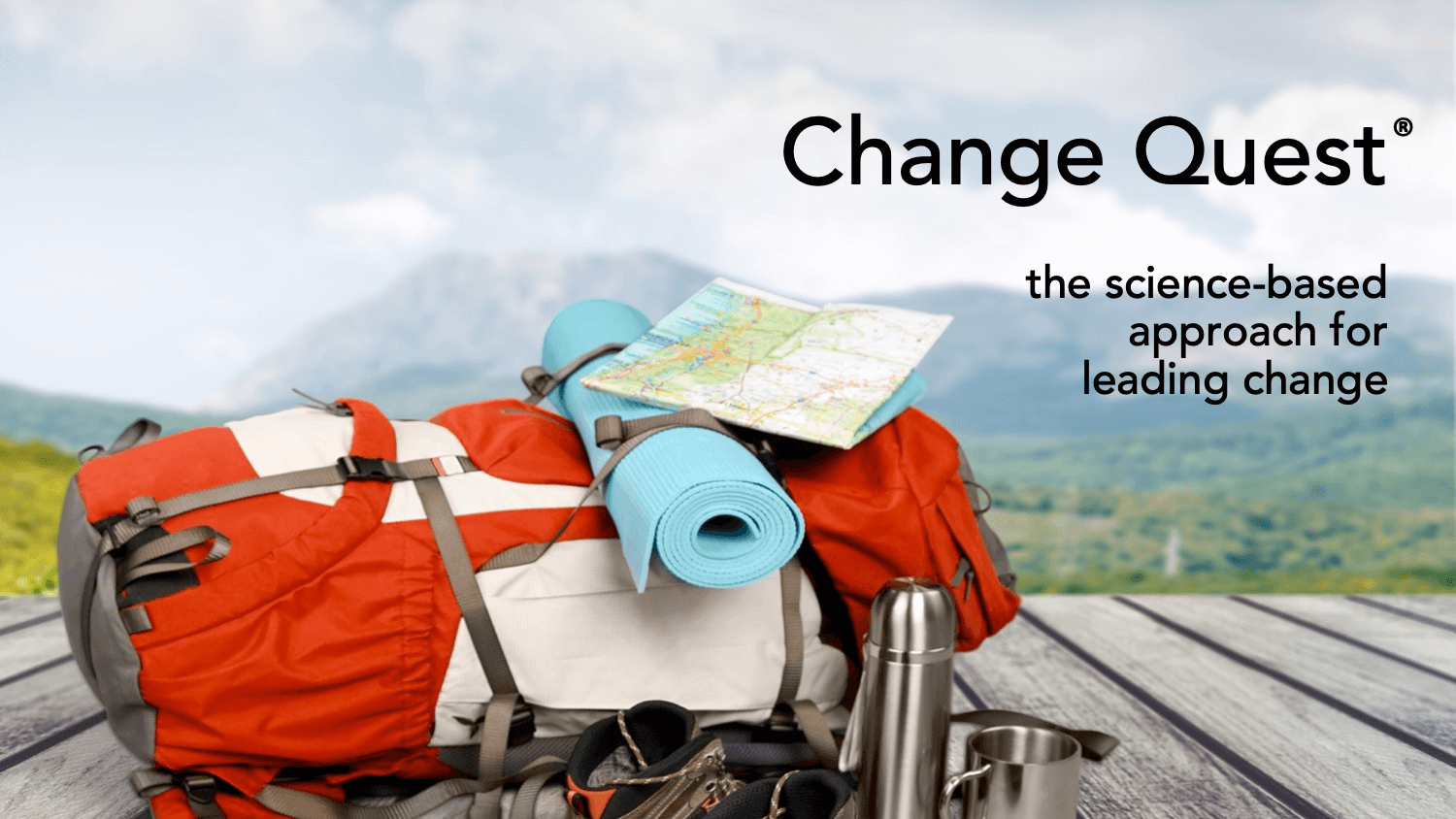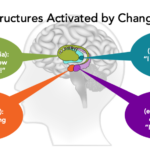This website uses cookies so that we can provide you with the best user experience possible. Cookie information is stored in your browser and performs functions such as recognising you when you return to our website and helping our team to understand which sections of the website you find most interesting and useful.
Introducing a New Brain-Based eCourse: Change Quest® for Managers

One of the many things you will learn in our change management training, are the three main types of tools: navigation, motivation, and connection, which can be applied together in different combinations to meet your teams' needs through a wide range of change types.
Navigation Tools: The Why and How of the Journey
The change journey is no different from any other traveling experience-it's an exercise in navigating through time and space. Employees of all kinds are much more likely to get to their destinations successfully if they have the right navigation tools. Hikers use geographic contour maps, compasses, and trail guides, while airline pilots use aviation charts and GPS systems. Here are two of the navigation tools, which should be incorporated into your change rollout and communication plan.
Start with Why
Before you start on any change journey, you should know why you are going in the first place. If you don't know why up front, you are missing a key element to good decision-making and motivation. And the purpose should not only be clear to you. You need to communicate the why to your team. Simon Sinek's book, Start with Why, says it all: Travelers need to know why they need to make the journey. In fact, the why is the center of what Sinek calls "the golden circle" that includes the how and the what. But the why must come first.
From the brain science perspective, knowing the why helps the amygdala perceive change as less threatening and helps travelers look into the future and anticipate potential gains. In fact, the more you spell out the purpose and potential gains for them, the sooner they can shift their focus.
Map the Route
Once you know the why you need to map your route. Getting from point A to point B requires you to identify each point's location and the best route between them. Most of today's change journeys are from a current state to a new, presumably better, future state. So the map might be expressed in gained revenue, decreased complaints, new product launch or any other metrics that matter to your business. However, you explain it, as the leader you have to tell people where they're headed and place a beacon there to guide them.
Creating a map of the journey is critical to your travelers' success because it keeps them from getting lost and it can also help them track their progress, boosting their sense of accomplishment. Like all good maps, it helps if you can add milestones and signposts along the way, again to help keep people on track and give them a sense of progress and accomplishment. And taking the entorhinal cortex into account, if the journey will affect your traveler's physical workspace or social network you will want to create literal maps of places and people too.
Motivation: Recognition and Rewards
Change Quest for Managers course also offers tools to motivate your travelers. Motivation is important for combatting the brain's natural resistance to change. It helps to address the various emotions that are part of the transition. Unless you are blessed with a group that has high choice and desire for the change, you will need to use various forms of recognition and rewards.
Recognize Effort and Progress
A key way to motivate your travelers is to recognize both effort and progress. Recognizing effort is part of fostering a growth mindset, which creates a culture of learning. Here are some examples of how feedback looks when it activates fixed and growth mindsets. Notice that a fixed mindset tends to frame feedback in terms of a trait whereas growth feedback focuses on effort and improvement.
During a change journey, you will have lots of opportunities to recognize effort and improvement and doing so will give your team a boost. This can be especially helpful for the travelers who did not want or choose the change and might be trudging along or digging in their heels. The more their effort is rewarded, the more likely both the basal ganglia and habenula will respond in ways that assist the change journey.
Use the Right Rewards
Recognition and praise are definitely rewarding but they are not the only ones. Remember, rewards play two vital roles in the neuroscience of change: (1) they help the habenula code an experience as a success, rather than a failure that it will try to avoid, and (2) they help the brain to want to replicate the behavior, because the basal ganglia see rewards as the third component in the habit loop.
Charles Duhigg, in his book The Power of Habit, compiled and synthesized studies on habit formation from MIT, Columbia University, and other institutions. All kinds of rewards can work. Social connection is a powerful reward because we respond to acknowledgment and encouragement. Getting that "Good job!" makes the basal ganglia very happy. When human skin touches human skin-think high five, pat on the back, or hug-our brain releases oxytocin, a feel-good chemical the basal ganglia loves.
And, of course, prizes, points, and chocolate work too. Rewards do not need to be big or showy, they just need to mark a success and be meaningful for your travelers. If you don't know what those are, ask them. By discussing rewards with them, you engage them in problem-solving and increase your change journey's likelihood of success.
Connection Tools: Patience and Empathy
Connection tools are powerful because they help build rapport and collaboration between and among your travelers. As we know, change can be a disruptive and difficult process that can trigger worry, anxiety, and fear. And moving through change requires risk-taking and vulnerability. So, building a team culture of trust and empathy is key to bringing out the best in your travelers.
Create Psychological Safety
The tech company Google studied hundreds of its teams around the world and found that psychological safety was what differentiated the best teams from the rest. Harvard researcher Dr. Amy Edmondson defines psychological safety as "a sense of confidence that the team will not embarrass, reject or punish someone for speaking up-it is a shared belief held by members of a team that the team is safe for interpersonal risk-taking. It describes a team climate characterized by interpersonal trust and mutual respect in which people are comfortable being themselves."
Google's study further identified that the who of a team is not relevant-it's the how: not who they are but how they work together. A productive team builds psychological safety through empathy and making sure that all members contribute equally, allowing every person's ideas and thoughts to be heard, and contributing to the collective success of the whole.
If you are leading a change journey, help create psychological safety by making sure you build a culture of empathy. Model empathy when you engage with your travelers and help them do the same. In addition, make sure that meetings allow each person to be heard and enable equal sharing. It's not enough to just ask if anyone has something to say. You have to make it safe and easy for even the quietest to contribute. If you need ideas, visit Google's re:Work site (ReWork. WithGoogle.com) where they share best practices from their study.
Patience. Patience. Patience.
Patience is crucial because leading a change journey can be hard work. Not only do you have your own experiences through the change initiative, but you are also now responsible for your travelers' experiences and success. You need to provide stability and guidance while expressing empathy and support. And sometimes your travelers will not show you the appreciation you deserve and they might even be snarky or grumpy.
Patience will be a tool that you use every day, particularly when you approach the peak of your change journey, and also near the end when everyone is running out of steam. Find ways to stay grounded and keep your sense of humor. Partner with another leader so you can coach and support each other, even commiserating when you need.
These are just a sample of the tools covered in Change Quest.
In this constantly changing world, it's critical to find leadership strategies that realistically address the human side of change. And because a change in our modern day has become both intense and relentless, our human biology is being pushed to its limits often driving chaos and confusion.
Looking to leverage knowledge from neuroscience, biology, and organizational psychology to lead your group through any change? If you're looking for change management training reach out to our team.
Related Blogs
JOIN OUR COMMUNITY
Be the first to know of Dr. Britt Andreatta's latest news and research.






